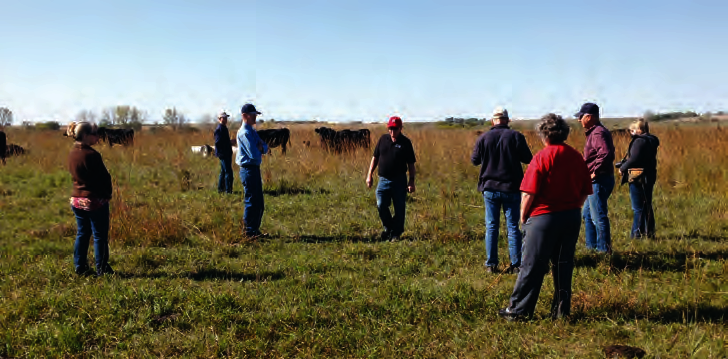Nebraska’s landscape is one of distant horizons, rolling plains, sandy hills, and acre after acre of agriculture. In a state where ninety-three percent of the state’s land is in production agriculture, cattle ranches span thousands of acres, and local food systems are on the rise, learning opportunities abounded for a group of educators like the Sustainable Agriculture Fellows. The Sustainable Agriculture Fellows program is a two-year training opportunity in sustainable agriculture for Extension workers. Supported by SARE and the National Association of County Agricultural Agents (NACAA), the program enhances understanding of sustainable agriculture and provides broad based, national exposure to successful and unique sustainable agriculture programs.
This fall, the fellows embarked on an agricultural tour of Nebraska and took an in-depth look at one Nebraska family farm. Tour stops included Nebraska farms, ranches and educational institutions, including the Horticulture Department and the Institute for the Culinary Arts at Metro Community College in Omaha, the University of Nebraska Lincoln’s Innovation Campus, Shadowbrook Farm’s high tunnels and creamery near Denton, the McLean family farm and feedlot near Benedict, Jim Knopik’s mob grazing ranch near Fullerton, The Grain Place (an organic farm and processing plant in Marquette), the Berns’ family farm and cover crop seed business near Bladen, and the Raising Nebraska Building at the Nebraska State Fair Grounds. Facilitated conversation kept the fellows engaged during locally sourced meals and van rides across the hills and plains of Nebraska.
The Fellows used a training tool developed by the Northeast SARE program called “Reading the Farm” to review detailed farm information, observe, and engage in facilitated discussion with Kevin Loth and Charuth Van Beuzekom Loth of Shadowbrook Farm and Dutch Girl Creamery near Denton, Nebraska. During the Reading the Farm exercise, the Fellows met with the Loth family and shared knowledge and insights within the context of the Loth’s vegetable farm and goat’s milk creamery businesses. After the tour, the fellows provided a written report summarizing their feedback for Shadowbrook Farm and Dutch Girl Creamery. That kind of engagement with producers and other Extension agents is one of the main draws to the Sustainable Agriculture Fellows program.
As we walked through pasture grasses at Jim Kopnik’s ranch the day after the Reading the Farm exercise, Utah State University Extension agent and 2013 Fellow, Matt Palmer, reflected on the program and explained how the Reading the Farm exercises have improved his interactions with farmers and have helped him better meet the needs of his local clientele. “It has been very valuable,” explained Palmer. “When I go back to the county that I’m from and I view farms, I understand how my recommendations interact with their other enterprises. I’m more apt to take a holistic view of their farm.”
Before sitting down to talk about cover crops with the Berns family at Green Cover Seed, University of Missouri Regional Horticultural Specialist and 2014 Fellow, Patrick Byers, echoed Palmer’s sentiments, saying that the Sustainable Agriculture Fellows program has fulfilled his expectations and more. “I’ve worked with farmers for many years,” said Byers. “This was a chance to delve more deeply into all aspects of sustainability and to build my skills as a person who is empathetic to the realities of sustainability for the farmers that I serve...I really can’t say enough things about what it has meant to me to be a Fellow.”
Curious about the Sustainable Agriculture Fellows program and the Reading the Farm tool? Learn about the people and the program online at sare.org/fellows.
